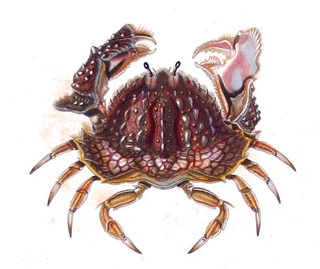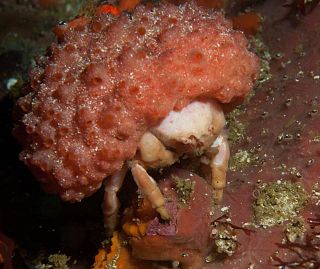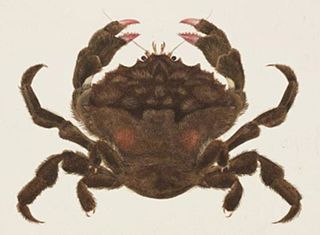
Libinia emarginata, the portly spider crab, common spider crab or nine-spined spider crab, is a species of stenohaline crab that lives on the Atlantic coast of North America.

Calappa hepatica, the reef box crab, is a common benthic species of box crab of tropical and subtropical parts of the Indian and Pacific Oceans and the Red Sea.

Notomithrax ursus, known as the hairy seaweed crab, is a spider crab of the family Majidae.

Decorator crabs are crabs of several different species, belonging to the superfamily Majoidea, that use materials from their environment to hide from, or ward off, predators. They decorate themselves by sticking mostly sedentary animals and plants to their bodies as camouflage, or if the attached organisms are noxious, to ward off predators through aposematism.

Mithraculus sculptus, the green clinging crab or emerald crab, is a species of crab in the family Majidae. It is a dark green colour and is found in tropical waters in the Caribbean Sea. It is sometimes kept in reef aquaria.

Achaeopsis spinulosa, the hotlips spider crab, is a species of crab in the family Inachidae, found only around the South African coast. It is the only species in the genus Achaeopsis.
Maja capensis, the Agulhas spider crab, is a species of crab in the family Majidae.

Pugettia producta, known as the northern kelp crab or shield-backed kelp crab, is a species of crab in the family Epialtidae.

Oregonia gracilis, commonly known as the graceful decorator crab, is a species of crab belonging to the family Oregoniidae. Like other decorator crabs it habitually attaches other organisms to its back. The sessile organisms are attached to hooked setae that act as a sort of velcro attachment. This decoration provides visual and chemical camouflage thus reducing predation risk. Pacific halibut are a major predator of O. gracilis. Other predators include octopus and sea otters. The main food source of O. gracilis is floating kelp and algae that they capture utilizing a waiting strategy in order to maintain cryptosis.

Lybia tessellata is a species of small crab in the family Xanthidae. It is found in shallow parts of the tropical Indo-Pacific Ocean. Like other members of the genus Lybia, it is commonly known as the pom-pom crab or boxer crab because of its habit of carrying a sea anemone around in each of its claws, these resembling pom-poms or boxing gloves.

Libinia dubia, the longnose spider crab, is a species of crab in the family Epialtidae. It is found in shallow waters on the eastern coast of North America.
Libinia ferreirae is a species of tropical spider crab in the family Epialtidae. It is found on the seabed in shallow waters off the Atlantic coast of South America.

Macropodia rostrata, common names, the common spider crab, long-legged spider crab, long-legged crab, is a species of marine crab in the family Inachidae. The Macropodia Rostrata visually mimics many other types of small crabs with the exception of its long legs. By attaching algae to their thin legs, they can be confused with the stem of seaweed. This is both a defense mechanism and a predatory advantage, as unsuspecting fish will hide in seaweed beds from nearby predators. This behavior can be absent among larger crabs, and those that live at great depths like giant Japanese spider crabs.

Hoplophrys is a monotypic genus of crab in the family Epialtidae. It contains the single species Hoplophrys oatesi, also known as the candy crab, Oates's soft coral crab, commensal soft coral crab and Dendronephthya crab.
Mithraculus cinctimanus is a species of crab in the family Majidae. It is found in the Caribbean region and is usually associated with a sea anemone, sponge or coral.

Dorippe frascone, the urchin crab or carrier crab, is a small species of crab in the family Dorippidae that was first described scientifically by J.F.W. Herbst, in 1785. It is found in the Red Sea and parts of the western and eastern Indian Ocean. It often has a symbiotic relationship with a long-spined sea urchin and carries one around on its carapace.

The furred sponge crab, Pseudodromia latens, is a species of crab in the family Dromiidae, often referred to as sponge crabs.
Portunus sayi, the sargassum swimming crab, is a species of pelagic crab in the family Portunidae. It is found in the western Atlantic Ocean and the Caribbean Sea where it makes its home among floating mats of Sargassum seaweed. It was named in honour of the American naturalist Thomas Say.
Lauridromia intermedia is a species of crab in the family Dromiidae and is native to the western Indo-Pacific. It often carries a piece of sponge on its back by way of camouflage, and one individual was found carrying a sea anemone in a similar manner.

Lauridromia dehaani is a species of crab in the family Dromiidae. It is native to the Red Sea and the western Indo-Pacific. It often carries a piece of sponge on its carapace by way of camouflage, and if unable to find a suitable piece of sponge, carries an empty bivalve shell, a sprig of seaweed or a piece of debris instead.















